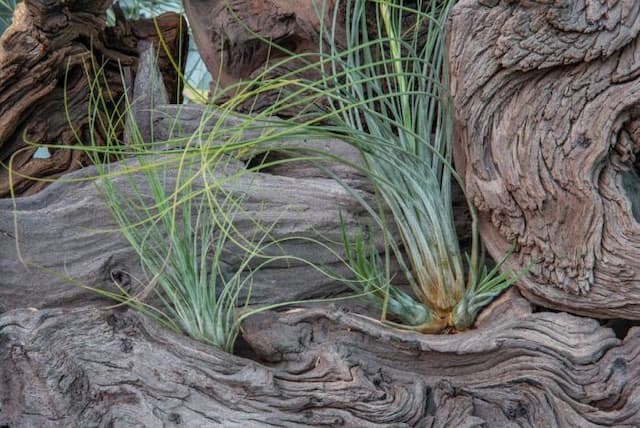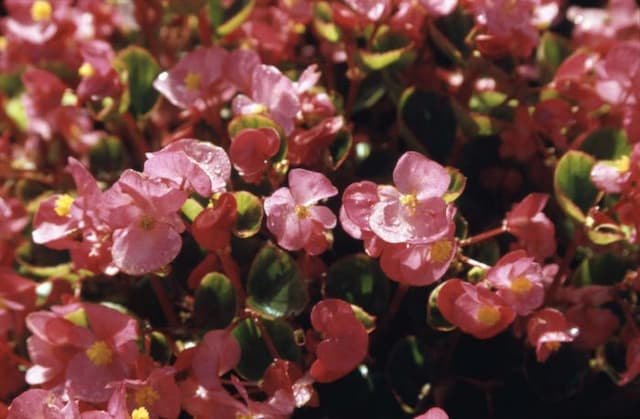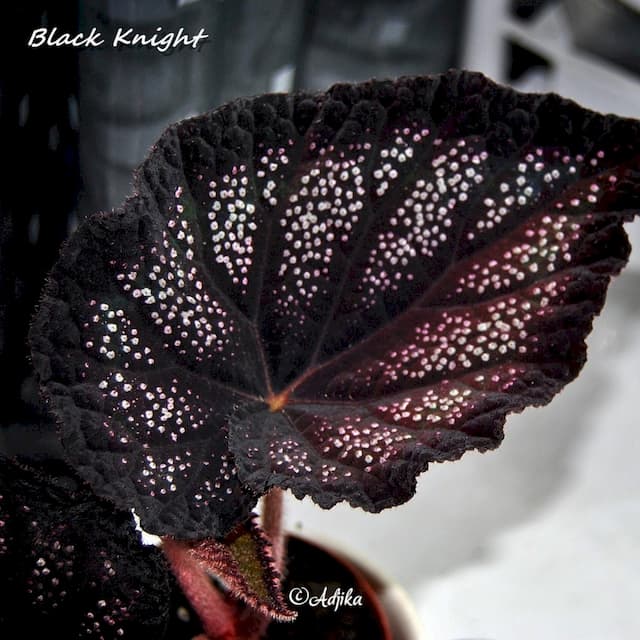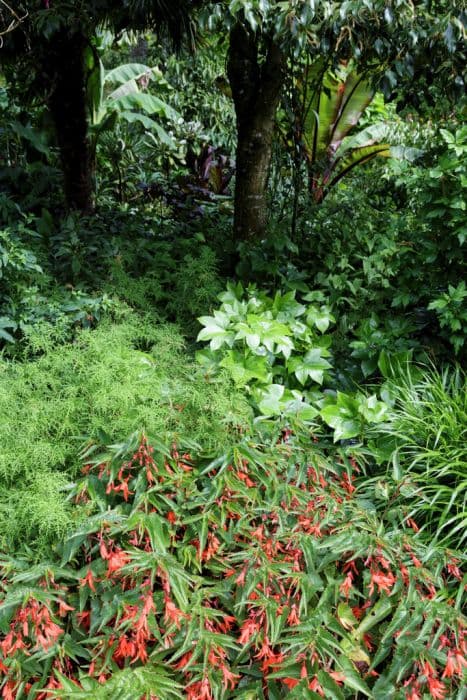Princess of Hanover Begonia Begonia 'Princess of Hanover' (R)

ABOUT
Begonia 'Princess of Hanover' is a charming cultivar with distinctive foliage and blooms. The leaves of this begonia boast a lush appearance, often with a heart-shaped base that extends out to a subtly wavy margin. They are typically a rich green hue, adorned with contrasting patterns or variegation which might include shades of silver, white, or even pale pink to add visual interest. During its blooming season, the plant produces flowers that contribute a burst of color to its overall appearance. The blossoms can be varying shades of pink, red, orange, or white, depending on the specific variety. These flowers are typically small to medium in size and grow in clusters, which create a delightful display against the backdrop of its ornate leaves. The begonia stands out for its symmetry and bushy growth habit, which gives the plant a dense, full look even without referencing its specific dimensions. Its stems can be either succulent or fibrous, sometimes with a hint of red or crimson that further accentuates the plant's beauty. Overall, Begonia 'Princess of Hanover' is a visually striking plant with its combination of detailed leaves and cheerful flowers, creating a lush and colorful addition to any plant collection or garden space without focusing on its exact size or measurements.
About this plant
 Names
NamesFamily
Begoniaceae
Synonyms
Princess of Hanover Begonia
Common names
Begonia 'Princess of Hanover'.
 Toxicity
ToxicityTo humans
Begonia 'Princess of Hanover' belongs to the Begonia genus which is known to contain compounds that can be irritating when ingested or handled. If parts of the begonia are consumed, they can cause irritation of the mouth and gastrointestinal tract, leading to symptoms such as drooling, difficulty swallowing, vomiting, and nausea. In most cases, begonia ingestion leads to mild to moderate symptoms, but if large amounts are eaten, it could lead to more severe digestive discomfort and potential complications.
To pets
Begonias, like the Begonia 'Princess of Hanover', are toxic to pets. If ingested by animals such as cats or dogs, they can cause irritation in the mouth, lips, tongue, and throat. This irritation can lead to symptoms like excessive drooling, vomiting, and difficulty swallowing. While the toxicity is typically mild to moderate, it can be uncomfortable for the pet, and in severe cases, ingestion can lead to more serious gastrointestinal issues. It's important to keep begonias out of reach of pets to prevent accidental ingestion.
 Characteristics
CharacteristicsLife cycle
Perennials
Foliage type
Evergreen
Color of leaves
Variegated
Flower color
Pink
Height
1-2 feet (30-60 cm)
Spread
1-2 feet (30-60 cm)
Plant type
Herb
Hardiness zones
10
Native area
Tropical South America
Benefits
 General Benefits
General Benefits- Decorative Appeal: Begonia 'Princess of Hanover' adds aesthetic value with its attractive foliage and blooms that can enhance the beauty of any garden or indoor space.
- Low Maintenance: It requires minimal care compared to many other ornamental plants, making it a convenient choice for busy gardeners.
- Long Blooming Season: The plant often has a prolonged flowering period that provides colorful displays for an extended time.
- Diversity in Landscaping: Its varying sizes and colors make it versatile for use in different landscape designs, from borders to container gardening.
- Shade Tolerance: This variety of begonia can thrive in shaded areas where other sun-loving plants might struggle.
- Non-Invasive: Begonias are generally compact and controlled in their growth habit, reducing the risk of them overtaking other plants in gardens.
- Adaptability: It adapts well to a range of indoor conditions, which is ideal for houseplant enthusiasts.
 Medical Properties
Medical PropertiesThis plant is not used for medical purposes.
 Air-purifying Qualities
Air-purifying QualitiesThis plant is not specifically known for air purifying qualities.
 Other Uses
Other Uses- Begonia 'Princess of Hanover' can be used in terrariums due to its compact growth habit and vibrant foliage, adding a touch of royal elegance to these miniature landscapes.
- The leaves of the begonia can be pressed and used in craft projects, such as creating botanical prints or adding natural elements to handmade papers.
- This variety of begonia is often used in fairy gardens, as their delicate appearance adds to the whimsical aesthetic of these miniature garden scenes.
- The plant can serve as an educational tool for children to learn about plant growth and care, owing to its easy-to-maintain nature and visible changes through seasons.
- Due to its unique appearance, Begonia 'Princess of Hanover' is a popular subject for botanical illustration and watercolor painting, providing inspiration for artists.
- The plant can act as a natural humidifier when grouped with other plants, creating a microenvironment with higher humidity that can benefit certain home decor setups.
- Begonia petals are sometimes used in culinary presentations as a decorative, non-toxic garnish for desserts and salads, adding a colorful flourish.
- Its vibrant colors and patterns can be used for color therapy sessions, where its soothing shades are believed to induce relaxation and stress relief.
- Begonias can be used as part of a living gift, such as in a "grow your own bouquet" kit, since they are attractive and relatively easy to care for.
- Photographers may use Begonia 'Princess of Hanover' as a prop in portrait and macro photography, utilizing the plant's detailed foliage and flowers to add depth and interest to their images.
Interesting Facts
 Feng Shui
Feng ShuiThe Begonia is not used in Feng Shui practice.
 Zodiac Sign Compitability
Zodiac Sign CompitabilityThe Begonia is not used in astrology practice.
 Plant Symbolism
Plant Symbolism- Caution: Begonias often symbolize caution or a warning to be careful. This may stem from the plant’s delicate nature, prompting one to handle the plant and situations with care.
- Harmony: The 'Princess of Hanover' variant, with its royal connotations, can imply a sense of balance and peaceful interactions, echoing the diplomacy usually associated with royalty.
- Uniqueness: This particular Begonia, with a title referencing nobility, might symbolize individuality and the distinctiveness that comes with its unique hybrid status.
 Water
WaterFor the Rieger begonia, water thoroughly once the top inch of soil feels dry to the touch, generally every 7 to 10 days, depending on environmental conditions. During watering, use room temperature water and aim to moisten the soil evenly throughout the pot. Avoid over-watering as it can lead to root rot; you may need about 16 ounces of water for a standard 6-inch pot each time you water. Reduce watering frequency in the winter months when the plant is not actively growing.
 Light
LightRieger begonias prefer bright, indirect sunlight. The best spot for these plants is a location where they can receive plenty of light without being exposed to the harsh midday sun, such as near an east or west-facing window. Direct sunlight can scorch their leaves, so make sure to provide light shade during the brightest part of the day.
 Temperature
TemperatureRieger begonias thrive in a temperature range between 65 and 72 degrees Fahrenheit but can tolerate temperatures as low as 50 degrees and as high as 75 degrees Fahrenheit. Avoid exposing the plant to temperatures below 50 degrees as this may damage the plant. They prefer a stable temperature and should be kept away from drafts and sudden temperature changes.
 Pruning
PruningPruning Rieger begonias is important for shaping the plant and removing dead or damaged leaves and stems. Prune as needed, typically after a flowering cycle, to encourage new growth and more robust blooms. The best time for pruning is late winter or early spring before new growth begins.
 Cleaning
CleaningAs needed
 Soil
SoilBegonias, such as the 'Princess of Hanover', thrive in a well-draining soil mix consisting of peat, perlite, and vermiculite with an ideal pH range of 5.5-6.5 to promote healthy growth.
 Repotting
RepottingThe 'Princess of Hanover' Begonia should be repotted every 1-2 years or when it becomes root-bound, typically in spring before the growing season begins.
 Humidity & Misting
Humidity & MistingBegonias like the 'Princess of Hanover' prefer a humidity level of 50-70% which mimics their natural tropical habitat.
 Suitable locations
Suitable locationsIndoor
Place in bright indirect light, keep moist, and maintain high humidity.
Outdoor
Partial shade, protect from strong wind, water when topsoil dries.
Hardiness zone
10-11 USDA
 Life cycle
Life cycleBegonia 'Princess of Hanover' (R), commonly known as Princess of Hanover Begonia, begins its life cycle as a seed, which after germination, emerges as a small seedling with a pair of initial leaves. As it grows, it develops its distinctive foliage, characterized by an attractive pattern of colors and a bushy habit, entering the vegetative stage. This is followed by the formation of buds that bloom into ornamental flowers, integral to the plant's aesthetic appeal and reproductive phase. After pollination, these flowers develop into fruit capsules containing seeds, completing the sexual reproductive cycle. In favorable conditions, the plant continues to grow and will produce flowers and seeds seasonally. As a perennial, Princess of Hanover Begonia can live for several years, going through cycles of vegetative growth and flowering, with periods of dormancy typically in cooler months.
 Propogation
PropogationPropogation time
Spring-Early Summer
The Begonia 'Princess of Hanover' is a variety that can be propagated through the popular method of stem cuttings. This technique is particularly beneficial due to the plant's tendency to root easily from segments of stems. To propagate this begonia, a healthy stem cutting of about 3 to 4 inches (approximately 7.5 to 10 centimeters) in length should be taken just below a leaf node. The lower leaves are then removed to expose a clean section of stem that can be inserted into a moistened potting mix. It's important to ensure that the soil stays consistently moist but not waterlogged, and that the cutting is placed in a warm environment with indirect light. With proper care, the cutting will develop roots within a few weeks, which can then be gradually acclimatized to less controlled conditions before being potted as a new plant.

![Begonia [Allure]](/_next/image?url=https%3A%2F%2Fplants-admin.emdemapps.com%2Fimages%2Fplants%2F%2Fimages%2F604b5b9006ab9.png&w=640&q=75)







